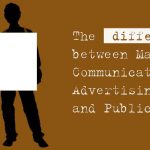There is a school of thought that says ‘advertising is dead, long live public relations’. And you can see where they’re coming from. A recent American study showed that we are exposed to as many as 4000 advertising messages a day – whether you get anywhere near this daily dose of companies poking their wares under your nose is debatable, but the truth is that there are a multitude of messages vying for the attention of potential punters at any one moment. Clearly, advertising is not dead, but through sheer numbers, it has become ineffectual. So how do you get your message over in this crowd of yelling people?
The trick to creating impact is to be different (while remaining on-brand) and memorable.
Keep it simple
Your starting point should be simplicity. Your potential clients are probably capable of understanding a complex message, but do you think they’ll have the time to decipher it? Test for yourself: drive past a dozen billboards, scoot up an escalator in the underground, peruse a magazine, surf* any website with banner ads, vegetate in front of a commercial break, and then ask yourself what do I remember and what was their message? You won’t be surprised when you realise that it’s next to nothing.
The problem, besides the overwhelming quantity, is that most advertising tries to say too much. Add to this that in many contexts (driving, escalator…) you have on average only a second to upload the information. Aim for 1 concise message then provide means to dive deeper. Any additional message dilutes the effectiveness of your main message.
“Yes, but advertising space is expensive and I’ve a lot to say” is a very familiar line that ad agencies have to deal with, and the killer response to this would be the effectiveness of a highly focused campaign. Unfortunately, very few types of advertising are accountable – there are just so many reasons why profits are made (or not) there’s little logic in making a whipping boy of the campaign.
A better argument is to consider a campaign as an integral part of the brand experience. A brand is built brick-by-brick and your advertising if it is noticed and remembered will constitute part of the company’s reputation. Advertising messages (and don’t forget that images are messages too) can swiftly build a brand, so don’t waste them, take them very seriously.
The checklist for effectiveness
So, let’s get into this; what are the constituent parts of an effective advert.
For any advert or campaign there are just 3 surprisingly simple objectives: attract the attention of potential customers, engage your audience so they are willing to receive all your message, and then encourage people to take action.
And for each of these points you need to take into account:
- Impact: is it a head-turner, does it surprise the reader and make them stop on your ad.
- Comprehension: the ability of the message to be understood by readers and to encourage them to act.
- Memorability: if it’s forgotten instantly then it serves no purpose. You can – if your budget allows – repeat the message until it sinks in. In this case, it becomes memorable … often for grating people’s nerves!
- Positioning: adapt the message to the desired brand image of the company and adapt your ads to better meet the concerns and tastes of the targeted customer.
Avoid copying
Copying is not good, especially if you’re exposed, and rest assured the person that’s been copied will make sure you are. The reality behind some copying incidents is that sometimes the person who had the ‘big idea’ was influenced by a previous similar advert/technique/gag/pun/art direction, and truly (and conveniently) forgot where it came from.
Another problem is that nothing is new; this not only applies to creative solutions but also to advertising problems. A benefit used to promote one product can be identical to a benefit used to promote a completely different product. The creative analyses of how to best vehicle this benefit could easily arrive at the same conclusion – copy and art direction included.
Copying and accidents happen, but to avoid them and as a sensible benchmarking practice, check out the competition and do your research.
Check and check again
This is a mantra at Pont Bleu, we’ve also written a series of articles about testing – see the ‘Fred’ articles in our blog – and it is something that cannot be repeated enough.
There are many things to check, like:
- Spelling, syntax, grammar and all the other written mistakes that will make you look a clown and discredit everything that is presented in the advert.
- Keywords for online advertising, get them wrong and nobody will see them.
- Imagery, is it believable does it give all the right messages?
- Technically, is it adequate for all targeted media? Inversely, is the media you have chosen still the right one for the advertising message…
… and, from an effective message point-of-view, ask yourself these questions:
- Do I understand the message?
- Is the benefit (to a problem) clearly highlighted?
- Does this ad tell me what to do next?
- Is the way to reach this company simple and complete?
- Am I going to stop to see this ad?
- Will it be beneficial for me?
- Is it boring? – the biggest advertising crime!
And then check again…
When the same people who have conceived an idea are the ones who check it then certain glaring errors can often get overlooked – that’s just the way it is.
So, whenever possible get other people to read it and give feedback, ideally these will be people within your target audience. Beware, it can be horrifyingly revealing!
Also, your eyes and ears treat words differently. Read your text aloud to make sure it is simple and clear. This tip will also weed-out clumsy formulations and unnecessarily long sentences that may go unnoticed when you read your text in your head.
….
Once you’ve ploughed-through this rather lengthy list and adapted as needed, you can be pretty sure that your advert will hit home and your media space money will not be wasted. Publish… and be damned!
* I’m sure that the term “surfing the web’ has become resolutely naff, but I just love the incongruous image of myself as a lithe, tanned, muscular dude, carving his way through digital waves, and eating doughnuts.

Branding Consultant at Pont Bleu Communication
Daren Birchall’s career spans more than 30 years. He is a graphic designer, writer, analyst and communications strategist, marketing consultant, media buyer, production manager, and for quite some time was an advertising agent. He loves photography but his glasses bother him.


